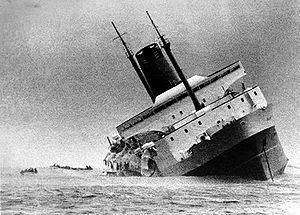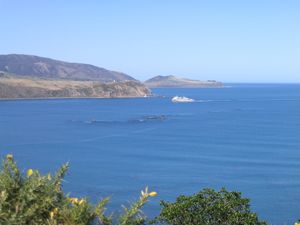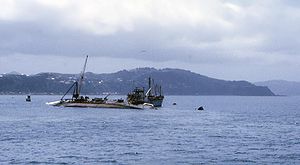Wahine disaster

The Wahine disaster occurred on 10 April 1968 when the TEV Wahine, a New Zealand inter-island ferry of the Union Company, foundered on Barrett Reef at the entrance to Wellington Harbour and capsized near Steeple Rock. Of the 610 passengers and 123 crew on board, 53 people lost their lives.[1]
The wrecking of the Wahine is one of the better known maritime disasters in New Zealand's history, although there have been worse with far greater loss of life. New Zealand radio and television captured the drama as it happened, within a short distance of shore of the eastern suburbs of Wellington, and flew film overseas for world TV news.
Contents
Disaster

Extreme weather conditions
In the early morning of 10 April, two violent storms merged over Wellington, creating a single extratropical cyclone storm that was the worst recorded in New Zealand's history. Cyclone Giselle was heading south after causing much damage in the north of the North Island. It hit Wellington at the same time as another storm which had driven up the West Coast of the South Island from Antarctica.[2] The winds in Wellington were the strongest ever recorded. At one point they reached a speed of 275 km/h and in one Wellington suburb alone ripped off the roofs of 98 houses. Three ambulances and a truck were blown onto their sides when they tried to go into the area to bring out injured people.
As the storms hit Wellington harbour, the ferry Wahine was crossing Cook Strait on the last leg of her overnight journey from the port of Lyttelton, near Christchurch, to Wellington. At the time she had set out, there had been no indication that the storms would be worse than those often experienced by vessels crossing the Cook Strait.[2]
Aground in Wellington Harbour
At 5:50 a.m., with winds gusting at between 130 and 150 km/h, Captain Hector Gordon Robertson decided to enter the harbour. Twenty minutes later the winds had increased to 160 km/h, and the ship lost its radar. A huge wave pushed the Wahine off course and in line with Barrett Reef. The captain was unable to turn back on course, and decided to keep turning the ferry around and back out to sea again. For 30 minutes the Wahine battled into the waves and wind, but by 6:40 a.m. had been driven back onto the rocks of Barrett Reef. Passengers were told that the ferry was aground, to put on their lifejackets and report to assembly points around the ship.
The storm continued to grow more intense. As the winds increased, the Wahine dragged its anchors and drifted into the harbour, close to the western shore. The weather was so bad that no help could be given from the harbour or the shore.
At about 11.00 a.m. a harbour tug managed to reach the vessel, and tried to attach a line and tow the ferry, but the line gave way. Other attempts failed, but the deputy harbourmaster managed to climb aboard the Wahine from the pilot launch, which had also reached the scene.
Ship abandoned, rolls over
At about 1.15 p.m. the combined effect of the tide and the storm swung the Wahine around, providing a patch of clear water sheltered from the wind. As the ferry suddenly listed further and reached the point of no return, Captain Robertson gave the order to abandon ship. Only four lifeboats could be launched. One lifeboat was swamped when it hit the water and people were lost into the sea. Some managed to hold onto the boat as it drifted across the harbour to the eastern shore. Other boats were also swamped but many of the passengers were able to reach the rescue boats which by now were surrounding the vessel.
At about 2.30 p.m. the Wahine rolled completely onto her side. By then the first of the survivors were reaching the western shore. Over 200 survivors drifted across to the rocky, unpopulated eastern side of the harbour.
On the eastern side the only road was blocked by land slips, and it became impassable due to the huge seas breaking over it. Some of the survivors reached the shore only to die of exhaustion or exposure. Fifty-one people died at the time, and two others died later from injuries sustained in the shipwreck, fifty-three victims in all. Most of the victims were middle-aged or elderly, along with several children, and died from drowning, exposure or injuries from being battered on the rocks. 46 people's bodies were found; 566 passengers were safe, as were 110 crew, and 6 were missing.
Aftermath
Investigation
Ten weeks after the shipwrecking, a Court of Inquiry found errors of judgement had been made, but stressed that the conditions at the time had been difficult and dangerous. Free surface effect caused the ferry to finally capsize due to a build-up of water on the vehicle deck, although several specialist advisers to the Inquiry believed that the ship had grounded a second time causing it to take on more water below decks. The report of the inquiry stated that more lives would almost certainly have been lost if the order to abandon ship had been given earlier or later. The storm was so strong that rescue craft would not have been able to safely help the passengers any earlier than about midday.[citation needed] Charges were brought against the ship's officers but all were acquitted.
Early hopes that the ship could be salvaged were eventually abandoned when the magnitude of structural damage became clear. As the wreck was a navigational hazard in Wellington Harbour, preparations were made over the following year to refloat the ship to allow it to be towed into Cook Strait for scuttling. However a nearly identical storm in 1969 broke up the wreck, and it was finally dismantled (partly by the Hikitia floating crane) where it lay.
Memorials
Today the Wahine Memorial Park marks the disaster, near where the survivors reached the shore at Seatoun. This park has a memorial plaque, the ship's anchor and chain, and replica ventilation pipes. A further plaque has also been placed on a rock at the parking area next to Burdans Gate on the eastern side of the harbour, marking the coast where many of the survivors and dead washed up. The Wahine's fore-mast is part of another memorial in Frank Kitts Park in central Wellington. The Museum of Wellington City & Sea has a permanent commemorative exhibition on their maritime floor that includes artifacts from the ship and a film about the storm and the sinking.
References
- ↑ Initially the official toll was 51, but two names were added 22 and 40 years later respectively. Kerry Williamson (2008-04-09). "Recognition 53rd Wahine victim". The Dominion Post. http://www.stuff.co.nz/stuff/4470696a11.html. Retrieved 2008-04-10.
- ↑ 2.0 2.1 Wahine Shipwreck (from the Christchurch Library website. Accessed 2008-06-07.)
- Emmanuel Makarios The Wahine Disaster: a tragedy remembered (2003, Grantham House; Wellington, N.Z.) ISBN 1869340795
- Max Lambert and Jim Hartley The Wahine Disaster (1969, Reed) & (1974, Collins Fontana Silver Fern)
- Kevin Boon The Wahine Disaster (1990, Nelson Price Milburn; Petone, N.Z.) ISBN 0-7055-1478-1 & (1999, Kotuku) (booklet, juvenile)
- T.E.V Wahine (O.N. 317814) Shipping casualty 10 April 1968 Report of Court and Annex Thereto, November 1968. This is the official report of the Court of Inquiry. It is extremely detailed and recommended for those who wish to do serious research into the disaster.
- C.W.N. Ingram New Zealand shipwrecks: 195 years of disaster at sea (Beckett, 1990; Auckland, N.Z.) ISBN 0-908676-49-2. This is the latest edition of a book first published in 1936. Arranged chronologically, the section on the Wahine gives an excellent hour-by-hour account of how the sinking happened as well as details of the Court of Inquiry which followed the disaster.
External links
- The Wahine disaster NZHistory.net.nz - includes images, sound and video
- The Wahine Murray Robinson's information-packed personal site detailing the ship's last hours, its history of operation, and the captain's career.
- The New Zealand Maritime Record: TEV Wahine Web Site is a detailed account of the ship, including the sinking, with many photographs.
- Wellington Public Library with books available
- Co-ordinating the rescue - Wahine Disaster - explores the ability of the police to respond to the Wahine disaster
- Deaths from the sinking of the T.E.V. Wahine lists those who perished in the disaster.
- The Wahine Disaster gives a good account of the sinking, with links to Hurricane Giselle and other New Zealand disasters.
- Revell & Gorman-The Wahine storm is a research paper published in the New Zealand Journal of Marine and Freshwater Research. This paper (available in pdf format) is an academic evaluation of the meteorology of Hurricane Giselle.
- The day the Wahine went down, from the Wairarapa Times Age, NZ
- On This Day BBC story on Wahine
- Trailer to 2008 Wahine Disaster Film
- Dominion Post photos of Wahine: enter, go to Categories:Archive;Wahine
- TVNZ DVD of Television documentary
- All articles with unsourced statements
- Articles with unsourced statements from June 2008
- Articles with invalid date parameter in template
- New Zealand articles missing geocoordinate data
- All articles needing coordinates
- Ferries of New Zealand
- Shipwrecks of New Zealand
- 1968 in New Zealand
- Maritime incidents in 1968

